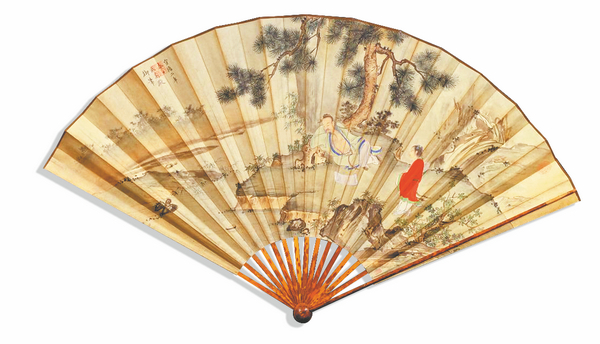

One day in the early 1920s, Luo Yinggong (1872-1924), one of China's most talented playwright-cum-Peking Opera impresarios of the time, bought an unpainted folding fan from a powerful collector-official with 40 gold ingots.
The main ribs of the fan are carved out of a special type of bamboo whose round, dark-colored patterns, resulting from microorganism infection, were reputed to have been formed as the sad tears of two bereaved ladies fell on the plant.
They were grieving the death of their husband, the legendary Emperor Shun whom some Chinese historians believe lived between 2200 and 2300 BC.
Equipped with the fan, Luo then knocked on the door of the much-revered painter Qi Baishi (1864-1957), whose brilliantly painted pair of butterflies would later appear on one side of the fan, along with his calligraphic transcription of a butterfly-themed poem by another of his equally renowned contemporaries.
There was now only one thing left to do: to record the event on the other side of the fan, which Luo did himself, noting that the fan "was meant as a birthday gift for Mr Mei" (Mei Lanfang, a master performer of Peking Opera).
Having written in the same inscription that "a thing (of beauty) will certainly be passed down across generations", Luo probably wouldn't be surprised when the fan was put up for bid nearly 90 years later during an auction held in Beijing in November 2011, where it fetched 3.22 million yuan ($444,100).
Yang Danxia, an expert on ancient Chinese painting from Beijing's Palace Museum, was at the auction preview.
"If anything, the story offers glimpses into a rather exclusive circle populated by Beijing's cultural elite at the time," she says.
One gathering place for its members was Lai Jin Yu Xuan Tea House, located today inside the former imperial altar-turned Zhongshan Park in central Beijing. The name of the tea house is a reference to a piece of writing by eighth-century poet Du Fu, on friendship.
"It was no coincidence that the tea house was where the daily activity of dou shanzi (fan contest) took place," says Yang.
According to her, a person entered his fan into this contest the moment he stepped into the tea house, the arrival announced by the crisp snap of a fan opening at a flick of the owner's wrist.
"Think about a Rolls-Royce coming to a halt in front of a luxury hotel, with its powerful engine letting out a deep roar. What that car did for its owner, a fan could do," she says.
A folding fan, apart from fanning gentle waves of cool air, could also be a veritable work of art, a statement accessory testifying to the standing of its carrier, especially in cultural circles.
"That's what set the folding fan apart from other types of fans that had appeared in Chinese history. For example, the circular-shaped tuanshan, or palace fan, was used almost exclusively by women," says Yang.
According to Yang, despite their modern usage, both the folding fan and the palace fan probably originated as items of etiquette.
Held up to face level, they served as small screens between a fan holder and another person who was most likely in a much-higher position, so that the former wouldn't be looking up directly into the latter's eyes during a meeting between the two.